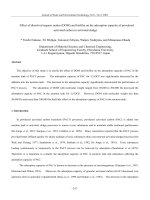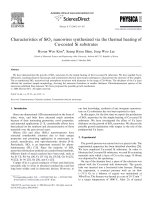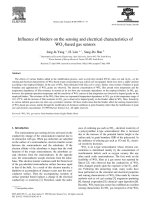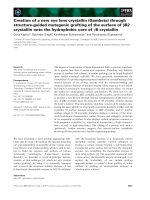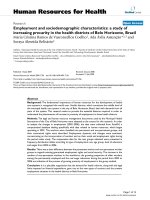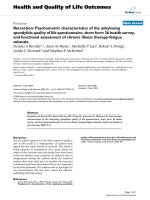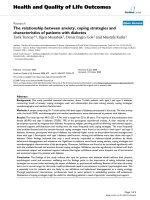Adsorption characteristics of Ni2+ ion onto the diethylenetriaminepentaacetic acid-melamine / polyvinylidene fluoride blended resin
Bạn đang xem bản rút gọn của tài liệu. Xem và tải ngay bản đầy đủ của tài liệu tại đây (666.36 KB, 12 trang )
INTERNATIONAL JOURNAL OF
ENERGY AND ENVIRONMENT
Volume 1, Issue 1, 2010 pp.121-132
Journal homepage: www.IJEE.IEEFoundation.org
Adsorption characteristics of Ni2+ ion onto the
diethylenetriaminepentaacetic acid-melamine /
polyvinylidene fluoride blended resin
Xiaodan Zhao, Laizhou Song, Jun He, Tingying Wu, Ying Qin
Department of Environmental and Chemical Engineering, Yanshan University, Qinhuangdao 066004,
China.
Abstract
The polyvinylidene fluoride blended resin (DTPA-MA/PVDF) adsorbent prepared by anchoring the
chelating agent diethylenetriaminepentaacetic acid (DTPA) to the resin via the amide covalent bond
reaction between DTPA and melamine(MA), was used to remove nickel from aqueous solutions. The
blended resin was prepared using the combination of solution blending technique and phase inversion
process. The blended resin was characterized by Fourier transform infrared spectroscopy (FTIR), 13C
nuclear magnetic resonance spectroscopy (13C NMR), environmental scanning electron microscopy
(ESEM) and N2 adsorption/desorption experiments. The sorption data was fit to linearized adsorption
isotherms of the Langmuir, Freundlich, and D-R isotherms models. The batch sorption kinetics was
evaluated using pseudo-first-order, pseudo-second-order, and intraparticle diffusion kinetic reaction
models. ∆H° is less than 0, ∆G° is lower than 0, and ∆S° is greater than 0, which shows that the
adsorption of Ni(II) by the blended resin is a spontaneous, exothermic process. The adsorption isotherm
fits better to the Langmuir isotherm model and the pseudo-second-order kinetics model gives a better fit
to the batch sorption kinetics. The adsorption mechanism is assumed to be ion exchange between the
nickel ion and the polyamino polycarboxylic acid chelating group of the blended resin.
Copyright © 2010 International Energy and Environment Foundation - All rights reserved.
Keywords: Diethylenetriaminepentaacetic acid, Heavy metal, Kinetics equation, Polyvinylidene
fluoride, Thermodynamics.
1. Introduction
Heavy metal contamination exists in aqueous waste effluents of many industries, such as metal plating
facilities, fertilizer industry, mining operations, and tanneries. Heavy metals in the environment are not
biodegradable and tend to accumulate in living organisms, causing various diseases and disorders [1].
Nickel and its compounds are ubiquitous in the environment and are, thus, found frequently in surface
water. Ni2+ ion is the most commonly occurring species in the environment and is toxic to living
organisms. The toxicity of nickel to living organisms is essentially exerted on enzymes, because nickel,
like other heavy metals, has a high affinity for ligands containing oxygen, nitrogen and sulfur donors. In
China, the acceptable limit of Ni2+ is 1.0 mg/L as industrial wastewater discharge [2]. Excess Ni2+ may
cause cancer of the lungs, nose and bone [3]. Acute nickel poisoning after ingestion may show systemic
effects such as headache, dizziness, nausea and vomiting, chest pain, dry cough and extreme weakness
[4].
ISSN 2076-2895 (Print), ISSN 2076-2909 (Online) ©2010 International Energy & Environment Foundation. All rights reserved.
122
International Journal of Energy and Environment (IJEE), Volume 1, Issue 1, 2010, pp.121-132
Therefore, nickel-containing wastewater needs to be treated before discharge. Numerous processes are
available for removing heavy metal ions to reduce heavy metal pollution in ecosystems, including
chemical precipitation, ion exchange, carbon adsorption, coprecipitation/adsorption, and membrane
filtration[5-15]. Nevertheless, many of these approaches are marginally cost effective or difficult to
implement in developing countries[16-18]. Therefore, a treatment strategy is needed that is simple,
robust, and that addresses local resources and constraints. One of the powerful treatment processes for
the removal of metal ions from water with a low cost is adsorption. Sorption operations, including
adsorption and ion exchange, are a potential alternative water and wastewater treatment technique.
Conventional porous solids, such as clay, fly ash, activated carbon and silica materials, have low
adsorption capacities with slow adsorption kinetics[19]. An ideal adsorbent should have accessible pore
structures with uniform pore size distributions and large surface areas with physical/chemical stability
and high uptake and stability[19,20]. Polyvinylidene fluoride (PVDF) has excellent mechanical and
physicochemical properties with good oxidation resistance to chemical reagents, which can be used for
adsorbents. However, conventional PVDF resin has no removal action on the soluble heavy metal ions.
Several approaches have been developed to adhere the acrylic acid group to PVDF polymers to produce a
hydrophilic surface with good ion-exchange performance[21-24]. But these techniques have drawbacks,
for example, the adsorbed polymer layer is easily removed during handling and surface grafting is likely
to change the polymer pore size and pore size distribution[24-27].
This study describes how the polyvinylidene fluoride blended resin (DTPA-MA/PVDF) adsorbent was
prepared by anchoring the chelating agent diethylenetriaminepentaacetic acid (DTPA) to the resin via the
amide covalent bond reaction between DTPA and melamine(MA), using solution blending and phase
inversion techniques. The blended resin was characterized using Fourier transform infrared spectroscopy
(FTIR), 13C nuclear magnetic resonance spectroscopy (13C NMR), environmental scanning electron
microscopy (ESEM) and N2 adsorption/desorption experiments. The Ni2+ ion sorption of the blended
resin from aqueous solution was measured, along with the adsorption isotherm and the batch sorption
kinetics.
2. Experimental
2.1 Materials
The PVDF powders were provided by Chen Guang Co. Ltd. (China) with a molecular weight of ca.
400000. Polyvinyl pyrrolidine (PVP) powders were supplied by the Institute of Chemical Engineering of
Beijing (China). Dimethylsulfoxide (DMSO), diethylenetriaminepentaacetic acid (DTPA) and
melamine(MA) were of analytical grade. All were used as received. In the current study, DTPA, MA and
PVDF were used for the blended resin material. The solvent DMSO was used to prepare the blended cast
solution. PVP was chosen as the pore-forming additive. A stock solution of Ni2+ (1000 mg/L) was
prepared by dissolving appropriate amounts of NiSO4·6H2O (analysis grade) in distilled water. The
working solutions were prepared by diluting the stock solutions to appropriate volumes.
2.2 Preparation of DTPA-MA/PVDF blended resin
First, DTPA and MA powders were dissolved in DMSO solvent. The concentrations of DTPA and MA
were 4.6 wt% and 4.4 wt%, respectively. The temperature of DMSO was kept at 180 to ensure the
complete amide covalent bond reaction between DTPA and MA. The solution was cooled below 100
as quickly as possible when some colloidal substances were found. Then the PVDF and PVP powders
were added into the aforementioned solution. The PVDF concentration was 11.5 wt%. The PVP
concentration was 2.5 wt%. The solution was completely dissolved in a water bath at 70~80 with
continuous stirring. After 3 h, the cast solution was degassed at 50~60 for 6 h in a water bath.
DTPA-MA/PVDF blended resin was prepared using phase inversion with distilled water as the nonsolvent. The blended cast solution was dropped into distilled water from a burette to create the resin
beads with diameters of 1.0~1.5 mm. After preparation, the blended resin beads were immersed in
distilled water for 48 h and then the resin was soaked in 1.0 mol/L HCl solution for 24 h. Then, the beads
were washed with distilled water until a neutral pH was obtained. The product was then dried at 75 for
several hours.
2.3 Characterization of DTPA-MA/PVDF blended resin
After dispersion in KBr, the FTIR spectra of the pristine PVDF powder and DTPA-MA/PVDF blended
resin were measured on E55+FRA106 FTIR spectrometer. Each spectrum was collected by cumulating
ISSN 2076-2895 (Print), ISSN 2076-2909 (Online) ©2010 International Energy & Environment Foundation. All rights reserved.
International Journal of Energy and Environment (IJEE), Volume 1, Issue 1, 2010, pp.121-132
123
16 scans at a resolution of 4 cm-1. BRUKER AVANCE III 400 NMR spectrometry (13C solid-state NMR)
was used to characterize the samples of DTPA-MA/PVDF blended resin. Surface and section
morphologies of the blended resin were analyzed using an ESEM (Model XL30, Philips). The N2
adsorption/desorption experiments were characterized using a Micromeritics ASAP 2010 analyzer with
the pore size distributions characterized using the Barret–Joyner–Halenda (BJH) model on the desorption
branch. The nickel ion sorption capacities were measured using atomic absorption spectrophotometer
(AAS) for the nickel content, according to the China Standard Methods for the Examination of Water
and Wastewater [28].
2.4 Sorption experiments
The stock solution was diluted as required to obtain standard solutions containing 20 to140 mg/L of Ni2+.
A 200 ml Ni2+ solution of the desired concentration, adjusted to the desired pH, was put into 250 mL
reagent bottles with known amounts of the blended resin. The solution pH was adjusted using HAcNaAc buffer solutions. All the chemicals used were of analytical reagent grade. The solutions were
agitated for a predetermined period in a shaking incubator at 288K, 298K, and 308K. The sorption
isotherm studies were carried out with different initial concentrations of Ni2+ while maintaining the
adsorbent dosage at constant levels. The pH effects were measured using 100 mg/L nickel ion solutions
and 0.5 g/100 mL of the blended resin. In order to correct for any adsorption of nickel on the container
surface, control experiments were carried out without adsorbent. No adsorption was found to occur on
the container walls. Kinetic experiments were conducted using a known weight of adsorbent with 100
mg/L Ni2+ at various temperatures. At various time intervals, suitable aliquots were analysed for the
nickel concentration. The rate constants were calculated using a conventional rate expression. The
amount of Ni2+ ion adsorbed by the blended resin was calculated according to equation (1)
q=[(C0–Ce)V]/W
(1)
where q is the amount of Ni2+ ion adsorbed onto a unit amount of the resin (mg⋅g–1), C0 and Ce are the
initial and equilibrium concentrations of Ni2+ ions in the aqueous phase (mg⋅L–1), V is the volume of the
aqueous phase (L) and W is the dry weight of the resin (g).
2.5 Desorption experiment
The regeneration and reuse of adsorbents is an important aspect of adsorption studies. The experiments
to measure the desorption efficiency were carried out with a 1.0 mol/L HCl solution. 1.0 g of the blended
resin with about 11.8 mg/g nickel ions was placed into 200 mL of HCl solution with agitation. The
desorption was quantified by measuring the nickel ion concentrations in the solution for various times up
to equilibrium. The desorption efficiency was expressed as equation (2)
DE= (q1/q0)×100%
(2)
where q1 is the desorbed amount of Ni2+ ion from the resin (mg⋅g–1) and q0 is the adsorbed amount of Ni2+
ion on the resin at equilibrium (mg⋅g–1). To examine the reusability of the blended resin, the adsorptiondesorption process was repeated for four cycles with the adsorption performance analyzed in each cycle.
The adsorption was conducted with 1.0 g of resin in 200 mL of 100 mg/L initial nickel ion concentration
at pH 6.6. During the adsorption and desorption processes, the solution temperature was kept as 298 K.
3 Results and discussion
3.1 Characterization of DTPA-MA/PVDF blended resin
3.1.1 FTIR analysis of DTPA-MA/PVDF blended resin
In order to investigate the complex formation in the DTPA-MA/PVDF blended resin, FTIR studies have
been carried out. FTIR spectra of the pristine PVDF resin and DTPA-MA/PVDF resin are shown in
Figure 1. The absorption peaks appearing at 3025, 471 and 1200cm-1 are assigned to PVDF C-F
stretching, wagging, and bending vibration modes, respectively[29], which are found to be weak in the
DTPA-MA/PVDF resin. The peak at 1552 cm-1 can be assigned to N-H bend of bridging secondary
amine of the blended resin, and the peak at 1493 cm-1 can be attributed to the methylene C-H bend of the
blended resin[30]. The –OH bending vibration of –COOH group of DTPA appears at 1340cm-1. The
ISSN 2076-2895 (Print), ISSN 2076-2909 (Online) ©2010 International Energy & Environment Foundation. All rights reserved.
124
International Journal of Energy and Environment (IJEE), Volume 1, Issue 1, 2010, pp.121-132
reported absorption peak at 1636 cm-1 is assigned to C=O mode of amide group[30], which is shifted to
1670 cm-1 in the blended resin. The FTIR spectra clearly demonstrate that the polyamino polycarboxylic
acid functional group has been blended to PVDF resin successfully.
100
Transmittance/%
90
80
-1
1200cm
-1
1340cm
-1
471cm
70
-1
3025cm
b
-1
1670cm
-1
1552cm
60
-1
1200cm
50
a
-1
3025cm
0
-1
1493cm
900
1800
2700
3600
4500
-1
Wave number/cm
Figure 1. FTIR spectra of the resins: (a) pristine PVDF, (b) DTPA-MA/PVDF
3.1.2 13C solid-state NMR analysis of DTPA-MA/PVDF blended resin
C solid-state NMR spectra of PVDF and DTPA–MA/PVDF resins are shown in Figure 2. The signals
at 20.1 ppm and 33.1 ppm can be assigned to adamantane which is used as the internal standard. The
signals which appears at 44.6 ppm and 121.8 ppm for PVDF can be assigned to -CH2- and -CF2groups[30], respectively. By a comparision of curve a with b in Figure 2, it can be seen there are three
new signals at 56.0 ppm, 158.7 ppm and 168.5 ppm in DTPA–MA/PVDF resin. The signal which
appears at 56.0 ppm is assigned to -CH2N- group of DTPA and the signal at 158.7 ppm can be assigned
to the three carbons in the triazine ring of MA. A high frequency signal appears at 168.5 ppm for the
blended resin, and strongly relates to carbonyl carbon of amide and/or carboxylic groups[31]. The
polyamino polycarboxylic acid chelating group has been blended to PVDF resin, and it can be inferred
that DTPA–MA/PVDF resin should possess a considerable adsorption capacity of Ni2+ ion.
13
a
b
44.6
PVDF
DTPA-MA/PVDF
33.1
168.5
20.1
121.8
56.0
158.7
b
a
-50
0
50
100
150
200
δ/ppm
250
Figure 2. 13C NMR of the resins: (a) pristine PVDF, (b) DTPA-MA/PVDF
ISSN 2076-2895 (Print), ISSN 2076-2909 (Online) ©2010 International Energy & Environment Foundation. All rights reserved.
International Journal of Energy and Environment (IJEE), Volume 1, Issue 1, 2010, pp.121-132
125
3.1.3 Surface and section morphologies of DTPA-MA/PVDF blended resin
The surface and section morphologies of DTPA-MA/PVDF blended resin were measured using ESEM.
SEM micrographs of the resin are shown in Figure 3. The micrograph in Figure 3a shows that pores are
distributed on the exterior surface of the blended resin with larger pores on the polymer surface and
many smaller pores in the interior. The micrograph in Figure 3b further shows that many pores are
distributed in the interior of the blended resin. When the blended resin is immersed into the Ni2+ solution,
the Ni2+ ion will diffuse into the resin through the pores in the exterior and interior surfaces of the
blended resin. Thus, the blended resin has a high Ni2+ ion adsorption capacity.
(a) Surface photograph
(b) Section photograph
Figure 3. SEM of the DTPA-MA/PVDF blended resin
ISSN 2076-2895 (Print), ISSN 2076-2909 (Online) ©2010 International Energy & Environment Foundation. All rights reserved.
126
International Journal of Energy and Environment (IJEE), Volume 1, Issue 1, 2010, pp.121-132
3.1.4 Specific surface area and pore size distribution in DTPA-MA/PVDF blended resin
The specific surface area and the pore size distribution of DTPA-MA/PVDF blended resin were
characterized by N2 adsorption/desorption tests. As shown in Figure 4a, the resin bead had a narrow pore
size distribution with a mean pore diameter of 0.24 µm and a specific surface area of 2.43 m2/g. The
location of the hysteresis loop in the N2 isotherm shown in Figure 4b can be used to determine whether
the blended resin possesses a regular framework of pores or interparticle voids, such as textural pores.
The framework porosity at 0.2-0.9 P/P0(P/P0 denoted as the relative pressure) on the N2 isotherm
indicates the porosity is contained in relatively uniform channels of the templated framework, while the
textural porosity at 0.9-1.0 P/P0 shows the porosity arising from the noncrystalline intra-aggregate voids
and spaces formed by interparticle contact [18]. Thus, the blended resin shows the presence of both
framework porosity and textural porosity. This suggests that the blended resin has a regular pore size
distribution.
0.5
0.3
3
-1
-1
dV/dD(cm .g .µm )
0.4
0.2
0.1
0.0
0.00
0.16
0.32
0.48
0.64
0.80
pore size(µm)
(a) Pore size distribution
2.4
3
Absorbed volume (cm /g STP)
3.0
1.8
1.2
0.6
0.0
0.0
0.2
0.4
0.6
0.8
1.0
0
Relative pressure (P/P )
(b) Isotherm
Figure 4. N2 adsorption/desorption curve for the blended rersin
ISSN 2076-2895 (Print), ISSN 2076-2909 (Online) ©2010 International Energy & Environment Foundation. All rights reserved.
International Journal of Energy and Environment (IJEE), Volume 1, Issue 1, 2010, pp.121-132
127
3.2 Effects of pH and initial Ni2+ concentration on the Ni2+ adsorption
The pH of a solution is an important parameter affecting adsorption processes because of the pH
dependency of complexation reactions and electrostatic interactions at the adsorption surface[32]. Since
the structure of the blended resin has the polyamino polycarboxylic acid chelating group, the pH
dependencies of the Ni2+ ion have to be determined. The effect of pH on the adsorption capacities of Ni2+
were examined by varying the initial pH of the solutions. The solution temperature was set to 298 K for
all the tests measuring and the variation of the metal uptake with pH is shown in Figure 5. The
adsorption capacities are found to be low at lower pH and to increase with increasing pH due to
competitive adsorption between the H+ ion and the Ni2+ ion for the same active adsorption site. As the pH
increases, the adsorption surface becomes less positive, so the electrostatic attraction between the Ni2+
ion and resin surface increases. The increased adsorption with pH may be further explained in terms of
the polyamino polycarboxylic acid chelating group on the resin. The functional group probably takes part
in the Ni2+ uptake process by a chelating complexation reaction which is pH-dependent, and the nature of
the active sites and Ni2+ ion may change with pH[33]. The optimum pH which gives the maximum Ni2+
uptake is 6.0~7.0.
12.5
pH=2.2
pH=3.5
pH=4.4
pH=5.3
pH=6.6
pH=7.5
qt(mg/g)
10.0
7.5
5.0
2.5
0
40
80
120
160
200
t(min)
Figure 5. Effect of pH on the adsorption of Ni2+ ions
The effect of the initial Ni2+ concentration on the Ni2+ adsorption capacity of the blended resin at 298 K
and pH 6.6 was studied with 7 g/L of blended resin and a contact time of 2 h. The results in Table 1 show
that with increasing initial Ni2+ concentration, the equilibrium adsorption capacity (qe) of the resin
increases, but the residual Ni2+ concentration is higher and the Ni2+ removal rate decreases.
Table 1. Effect of initial Ni2+ concentration on the resin’s adsorption capacity
Initial Ni2+ /
(mg⋅L–1)
19.25
39.28
59.74
79.37
103.39
119.65
139.42
Residual
Ni2+/(mg⋅L–1)
2.18
5.68
10.47
16.23
24.32
31.52
42.02
qe/(mg⋅g–1)
Ni2+ removal/(%)
2.56
5.04
7.39
9.47
11.86
13.22
14.61
88.68
85.54
82.47
79.55
76.48
73.66
69.86
3.3 Effect of contact time and sorption kinetics
The Ni2+ ion uptake capacities were measured as a function of time to determine the optimum contact
time for the adsorption of Ni2+ ion on the blended resin. Figure 6 shows the time course of the adsorption
ISSN 2076-2895 (Print), ISSN 2076-2909 (Online) ©2010 International Energy & Environment Foundation. All rights reserved.
128
International Journal of Energy and Environment (IJEE), Volume 1, Issue 1, 2010, pp.121-132
equilibrium of Ni2+ ions onto the blended resin. There is rapid uptake for the first 60 min with adsorption
equilibrium attained within 120 min. Actually, the adsorption is very close to equilibrium within the first
90 min. Therefore, 2 h of contact time was chosen as the optimum equilibration time for the experimental
studies, unless otherwise stated, to ensure that equilibrium was achieved.
15
qt(mg/g)
12
9
288K
298K
308K
6
3
0
0
30
60
90
120
150
t(min)
Figure 6. Effects of contact time and temperature on the adsorption of Ni2+ ions
Adsorption processes are controlled by various mechanisms, such as mass transfer, mass diffusion,
chemical reactions and particle diffusion. To clarify the mechanisms controlling the adsorption, several
adsorption models were used to evaluate the experimental data. The kinetics were compared to a pseudofirst-order kinetic model, a pseudo-second-order kinetic model and an intraparticle diffusion model. The
calculated qe and correlation coefficients (R2) for various temperatures are summarized in Table 2, where
kp1, kp2 and kid is the rate constant of pseudo-first-order kinetic model (min–1), pseudo-second-order
kinetic model (g⋅(mg⋅min)–1) and intraparticle diffusion model (mg⋅ (g⋅min1/2)–1), respectively, and T is
the temperature. The data indicates that the kinetics of the pseudo-second-order kinetics model better
represents the experimental data than the pseudo-first-order rate model or the intraparticle diffusion
model.
Table 2. First-order, second-order and intraparticle diffusion rate constants
Pseudo-first-order kinetic model
T/K
kp1
(min–1)
288
298
308
0.0566
0.0613
0.0717
qe
(mg⋅g –1)
16.2836
10.9206
10.2125
Pseudo-second-order kinetic model
Intraparticle diffusion model
R2
kp2
[g⋅ (mg⋅min)–1]
qe
(mg⋅g –1)
R2
kid
[mg⋅(g⋅min1/2) –1]
R2
0.9983
0.9765
0.9889
0.0061
0.0055
0.0045
14.8038
14.1743
13.5906
0.9984
0.9989
0.9996
1.3883
1.3108
1.2283
0.9530
0.9532
0.9581
3.4 Effect of temperature and sorption isotherms
The effect of temperature on the Ni2+ ion uptake was investigated by varying the temperature of the
solution with pH as 6.6. The data in Figure 6 shows that the adsorption capacity increases with increasing
temperature to a plateau which represents the maximum adsorption capacity of the blended resin. This
increase in loading capacity of the resin with temperature represents an exothermic process. The
equilibrium adsorption capacity of Ni2+ on the blended resin at 288 K is 12.12 mg/g, at 298 K is 11.88
mg/g, and at 308K is 11.52 mg/g.
ISSN 2076-2895 (Print), ISSN 2076-2909 (Online) ©2010 International Energy & Environment Foundation. All rights reserved.
International Journal of Energy and Environment (IJEE), Volume 1, Issue 1, 2010, pp.121-132
129
The isotherm data can be used to develop an equation for design purposes. The experimental data for the
effect of temperature on the adsorption capacity was evaluated relative to the three popular adsorption
models, the Langmuir, Freundlich and D-R models. In Table 3, qm is the maximum sorption capacity
(mg⋅g–1), Ka is the Langmuir constant (L⋅g–1), and E is the mean free energy of adsorption (kJ⋅mol–1). The
results listed in Table 3 show that the Ni2+ ion sorption isotherms can be explained by all three models
but that the Langmuir equation gives the best fit. This result also predicts the mono-molecular layer of
the adsorption sites on the blended resin. The Freundlich constant, KF, indicates the sorption capacity of
the resin. As can be seen from Table 3, KF was 7.45 at 288 K, 7.21 at 298 K and 6.75 at 308 K for the
Ni2+ adsorption. The heterogenity factor n were all found to be greater than 1. This result is very common
and may be due to the distribution of surface sites or other factors that reduce the adsorbent–adsorbate
interaction with increasing surface density [34]. The D-R isotherm model results show that the mean free
energy of adsorption (E) is between 8 and 16 kJ/mol, so it is possible that the adsorption Ni2+ ions on the
blended resin can be explained as an ion-exchange process[35].
Table 3. Langmuir, Freundlich and D-R isotherm constants
Langmuir isotherm
T/K
288
298
308
–1
qm/(mg⋅g )
15.7903
15.3917
14.8610
–1
Ka/(L⋅g )
0.1325
0.1313
0.1312
Freundlich isotherm
2
R
0.9974
0.9975
0.9983
KF
7.4526
7.2124
6.7473
n
6.7431
6.6489
6.3012
D-R isotherm
2
R
0.9867
0.9929
0.9951
–1
qm/(mg⋅g )
24.9115
23.6979
23.5064
E/(kJ⋅mol–1)
15.08
15.93
15.93
R2
0.9924
0.9929
0.9993
The thermodynamic parameters such as the standard free energy change (∆G°), standard enthalpy change
(∆H°), and standard entropy change (∆S°) were estimated[35,36].
log K D = −
∆H 0
∆S 0
+
2.303 RT
R
(3)
∆ G 0 = ∆H 0 − T ∆ S 0
(4)
where KD is the distribution coefficient (mL⋅g–1), and R is the gas constant (kJ⋅mol–1⋅K–1). The calculated
thermodynamic parameters are listed in Table 4. ∆H° is negative for all cases due to the exothermic
nature of the adsorption. The negative ∆G° indicates the spontaneous nature of the reaction and the
decreasingly negative ∆G° with temperature indicates that the reaction is more favored at lower
temperatures. The values of ∆S° are positive due to the exchange of Ni2+ ions with more mobile ions on
the resin, which increases the entropy during the adsorption process[37]. The values in Table 4 show that
the adsorption of Ni2+ by the blended resin is a spontaneous, exothermic process.
Table 4. Thermodynamic parameters for the adsorption of Ni2+ on the blended resin
T/K
288
298
308
∆G°/(kJ⋅mol–1)
-7.71
-7.88
-8.05
∆H°/(kJ⋅mol–1)
—
-2.69
—
∆S°/(J⋅mol–1⋅K–1)
—
17.40
—
3.5 Desorption of the blended resin
Good desorption of an adsorbent is important for potential practical applications. Figure 7 shows the
amount of nickel ions adsorbed on DTPA-MA/PVDF blend resin in four adsorption/desorption cycles.
The results show that the blended resin still has good adsorption/desorption capability. After four cycles,
the adsorption capacity of the blended resin is greater than 11 mg/g and its desorption efficiency is above
90%. Therefore, the blended resin can be reused without any significant loss in the adsorption
performance. Therefore, for the further research on the blended resin should be done, such as the
treatment of the nickel plating spent solutions.
ISSN 2076-2895 (Print), ISSN 2076-2909 (Online) ©2010 International Energy & Environment Foundation. All rights reserved.
130
International Journal of Energy and Environment (IJEE), Volume 1, Issue 1, 2010, pp.121-132
Adsorption capacity(mg/g)
12
9
6
3
0
0
4
8
12
16
20
t(h)
Figure 7. Repeated adsorption /desorption curves for DTPA-MA/PVDF blended resin
4. Conclusions
A blended resin containing the polyamino polycarboxylic acid chelating group was synthesized for the
adsorption of Ni2+ ions. Experimental results show that the resin effectively removes nikel ions in
synthetic solutions for pH from 2 to 7. Adsorption on the blended resin is best modeled by the Langmuir
adsorption isotherms model, which shows the mono-molecular layer characteristics of the adsorption
sites on the resin. The adsorption of Ni2+ ions onto the blended resin was found to be an ion-exchange
process. The adsorption process was found to be an exothermic, spontaneous, and pseudo-second-order
kinetic process. This blended resin can be used to treat waste to reduce environmental pollution and
deserves further extensive study.
References
[1] Aaseth J., Norseth T. Handbook on the Toxicity of Metals. Elsevier, Netherlands, 1986.
[2] Chinese wastewater emission Standard
